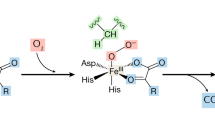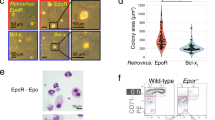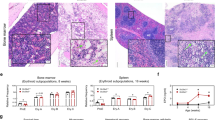Abstract
The hormone erythropoietin (EPO), which is synthesized in the kidney or liver of adult mammals, controls erythrocyte production and is regulated by the stress-responsive transcription factor hypoxia-inducible factor-2 (HIF-2). We previously reported that the lysine acetyltransferase CREB-binding protein (CBP) is required for HIF-2α acetylation and efficient HIF-2–dependent EPO induction during hypoxia. We now show that these processes require acetate-dependent acetyl CoA synthetase 2 (ACSS2). In human Hep3B hepatoma cells and in EPO-generating organs of hypoxic or acutely anemic mice, acetate levels rise and ACSS2 is required for HIF-2α acetylation, CBP–HIF-2α complex formation, CBP–HIF-2α recruitment to the EPO enhancer and efficient induction of EPO gene expression. In acutely anemic mice, acetate supplementation augments stress erythropoiesis in an ACSS2-dependent manner. Moreover, in acquired and inherited chronic anemia mouse models, acetate supplementation increases EPO expression and the resting hematocrit. Thus, a mammalian stress-responsive acetate switch controls HIF-2 signaling and EPO induction during pathophysiological states marked by tissue hypoxia.
This is a preview of subscription content, access via your institution
Access options
Subscribe to this journal
Receive 12 print issues and online access
$209.00 per year
only $17.42 per issue
Buy this article
- Purchase on Springer Link
- Instant access to full article PDF
Prices may be subject to local taxes which are calculated during checkout






Similar content being viewed by others
References
Bunn, H.F. & Poyton, R.O. Oxygen sensing and molecular adaptation to hypoxia. Physiol. Rev. 76, 839–885 (1996).
Richalet, J.P. Oxygen sensors in the organism: examples of regulation under altitude hypoxia in mammals. Comp. Biochem. Physiol. A Physiol. 118, 9–14 (1997).
Koury, M.J. Erythropoietin: the story of hypoxia and a finely regulated hematopoietic hormone. Exp. Hematol. 33, 1263–1270 (2005).
Wang, G.L., Jiang, B.H., Rue, E.A. & Semenza, G.L. Hypoxia-inducible factor 1 is a basic-helix-loop-helix-PAS heterodimer regulated by cellular O2 tension. Proc. Natl. Acad. Sci. USA 92, 5510–5514 (1995).
Semenza, G.L. Regulation of oxygen homeostasis by hypoxia-inducible factor 1. Physiology (Bethesda) 24, 97–106 (2009).
Semenza, G.L. Involvement of oxygen-sensing pathways in physiologic and pathologic erythropoiesis. Blood 114, 2015–2019 (2009).
Tian, H., McKnight, S.L. & Russell, D.W. Endothelial PAS domain protein 1 (EPAS1), a transcription factor selectively expressed in endothelial cells. Genes Dev. 11, 72–82 (1997).
Ema, M. et al. A novel bHLH-PAS factor with close sequence similarity to hypoxia-inducible factor 1α regulates VEGF expression and is potentially involved in lung and vascular development. Proc. Natl. Acad. Sci. USA 94, 4273–4278 (1997).
Flamme, I. et al. HRF, a putative basic helix-loop-helix-PAS-domain transcription factor is closely related to hypoxia-inducible factor 1α and developmentally expressed in blood vessels. Mech. Dev. 63, 51–60 (1997).
Warnecke, C. et al. Differentiating the functional role of hypoxia-inducible factor (HIF)-1α and HIF-2α (EPAS-1) by the use of RNA interference: erythropoietin is a HIF-2α target gene in Hep3B and Kelly cells. FASEB J. 18, 1462–1464 (2004).
Scortegagna, M., Morris, M.A., Oktay, Y., Bennett, M. & Garcia, J.A. The HIF family member EPAS1/HIF-2α is required for normal hematopoiesis in mice. Blood 102, 1634–1640 (2003).
Scortegagna, M. et al. HIF-2α regulates murine hematopoietic development in an erythropoietin-dependent manner. Blood 105, 3133–3140 (2005).
Dioum, E.M. et al. Regulation of hypoxia-inducible factor 2α signaling by the stress-responsive deacetylase sirtuin 1. Science 324, 1289–1293 (2009).
Rankin, E.B. et al. Hypoxia-inducible factor-2 (HIF-2) regulates hepatic erythropoietin in vivo. J. Clin. Invest. 117, 1068–1077 (2007).
Kapitsinou, P.P. et al. Hepatic HIF-2 regulates erythropoietic responses to hypoxia in renal anemia. Blood 116, 3039–3048 (2010).
Chen, R. et al. The acetylase/deacetylase couple CREB-binding protein/sirtuin 1 controls hypoxia-inducible factor 2 signaling. J. Biol. Chem. 287, 30800–30811 (2012).
Papandreou, I., Cairns, R.A., Fontana, L., Lim, A.L. & Denko, N.C. HIF-1 mediates adaptation to hypoxia by actively downregulating mitochondrial oxygen consumption. Cell Metab. 3, 187–197 (2006).
Kim, J.W., Tchernyshyov, I., Semenza, G.L. & Dang, C.V. HIF-1-mediated expression of pyruvate dehydrogenase kinase: a metabolic switch required for cellular adaptation to hypoxia. Cell Metab. 3, 177–185 (2006).
Zaidi, N., Swinnen, J.V. & Smans, K. ATP-citrate lyase: a key player in cancer metabolism. Cancer Res. 72, 3709–3714 (2012).
Fujino, T., Kondo, J., Ishikawa, M., Morikawa, K. & Yamamoto, T.T. Acetyl-CoA synthetase 2, a mitochondrial matrix enzyme involved in the oxidation of acetate. J. Biol. Chem. 276, 11420–11426 (2001).
Luong, A., Hannah, V.C., Brown, M.S. & Goldstein, J.L. Molecular characterization of human acetyl-CoA synthetase, an enzyme regulated by sterol regulatory element-binding proteins. J. Biol. Chem. 275, 26458–26466 (2000).
Loikkanen, I., Haghighi, S., Vainio, S. & Pajunen, A. Expression of cytosolic acetyl-CoA synthetase gene is developmentally regulated. Mech. Dev. 115, 139–141 (2002).
Barth, C., Sladek, M. & Decker, K. The subcellular distribution of short-chain fatty acyl-CoA synthetase activity in rat tissues. Biochim. Biophys. Acta 248, 24–33 (1971).
Wellen, K.E. et al. ATP-citrate lyase links cellular metabolism to histone acetylation. Science 324, 1076–1080 (2009).
Chen, R., Dioum, E.M., Hogg, R.T., Gerard, R.D. & Garcia, J.A. Hypoxia increases sirtuin 1 expression in a hypoxia-inducible factor-dependent manner. J. Biol. Chem. 286, 13869–13878 (2011).
Yoshii, Y. et al. Cytosolic acetyl-CoA synthetase affected tumor cell survival under hypoxia: the possible function in tumor acetyl-CoA/acetate metabolism. Cancer Sci. 100, 821–827 (2009).
Lord, B.I. & Murphy, M.J. Jr. Hematopoietic stem cell regulation. II. Chronic effects of hypoxic-hypoxia on CFU kinetics. Blood 42, 89–98 (1973).
McBrian, M.A. et al. Histone acetylation regulates intracellular pH. Mol. Cell 49, 310–321 (2013).
Hjelmeland, A.B. et al. Acidic stress promotes a glioma stem cell phenotype. Cell Death Differ. 18, 829–840 (2011).
Laderoute, K.R. et al. 5′-AMP-activated protein kinase (AMPK) is induced by low-oxygen and glucose deprivation conditions found in solid-tumor microenvironments. Mol. Cell. Biol. 26, 5336–5347 (2006).
Leelahavanichkul, A. et al. Angiotensin II overcomes strain-dependent resistance of rapid CKD progression in a new remnant kidney mouse model. Kidney Int. 78, 1136–1153 (2010).
Brox, A.G., Zhang, F., Guyda, H. & Gagnon, R.F. Subtherapeutic erythropoietin and insulin-like growth factor-1 correct the anemia of chronic renal failure in the mouse. Kidney Int. 50, 937–943 (1996).
Russell, E.S. Analysis of pleiotropism at the W-locus in the mouse; relationship between the effects of W and Wv substitution on hair pigmentation and on erythrocytes. Genetics 34, 708–723 (1949).
Kabaya, K. et al. Improvement of anemia in W/WV mice by recombinant human erythropoietin (rHuEPO) mediated through EPO receptors with lowered affinity. Life Sci. 57, 1067–1076 (1995).
Tonia, T. et al. Erythropoietin or darbepoetin for patients with cancer. Cochrane Database Syst. Rev. 12, CD003407 (2012).
Cao, Y. Erythropoietin in cancer: a dilemma in risk therapy. Trends Endocrinol. Metab. 24, 190–199 (2013).
Zhou, B. et al. Erythropoietin promotes breast tumorigenesis through tumor-initiating cell self-renewal. J. Clin. Invest. 124, 553–563 (2014).
Yamashita, H., Kaneyuki, T. & Tagawa, K. Production of acetate in the liver and its utilization in peripheral tissues. Biochim. Biophys. Acta 1532, 79–87 (2001).
O'Connor, P.M. Renal oxygen delivery: matching delivery to metabolic demand. Clin. Exp. Pharmacol. Physiol. 33, 961–967 (2006).
Jungermann, K. & Kietzmann, T. Oxygen: modulator of metabolic zonation and disease of the liver. Hepatology 31, 255–260 (2000).
Rabkin, M. & Blum, J.J. Quantitative analysis of intermediary metabolism in hepatocytes incubated in the presence and absence of glucagon with a substrate mixture containing glucose, ribose, fructose, alanine and acetate. Biochem. J. 225, 761–786 (1985).
Crabtree, B., Gordon, M.J. & Christie, S.L. Measurement of the rates of acetyl-CoA hydrolysis and synthesis from acetate in rat hepatocytes and the role of these fluxes in substrate cycling. Biochem. J. 270, 219–225 (1990).
Crabtree, B., Marr, S.A., Anderson, S.E. & MacRae, J.C. Measurement of the rate of substrate cycling between acetate and acetyl-CoA in sheep muscle in vivo. Effects of infusion of acetate. Biochem. J. 243, 821–827 (1987).
Crabtree, B. & Newsholme, E.A. Sensitivity of a near-equilibrium reaction in a metabolic pathway to changes in substrate concentration. Eur. J. Biochem. 89, 19–22 (1978).
Gordon, M.J. & Crabtree, B. The effects of propionate and butyrate on acetate metabolism in rat hepatocytes. Int. J. Biochem. 24, 1029–1031 (1992).
Waniewski, R.A. & Martin, D.L. Preferential utilization of acetate by astrocytes is attributable to transport. J. Neurosci. 18, 5225–5233 (1998).
Mahon, P.C., Hirota, K. & Semenza, G.L. FIH-1: a novel protein that interacts with HIF-1α and VHL to mediate repression of HIF-1 transcriptional activity. Genes Dev. 15, 2675–2686 (2001).
Lando, D. et al. FIH-1 is an asparaginyl hydroxylase enzyme that regulates the transcriptional activity of hypoxia-inducible factor. Genes Dev. 16, 1466–1471 (2002).
Bracken, C.P. et al. Cell-specific regulation of hypoxia-inducible factor (HIF)-1α and HIF-2α stabilization and transactivation in a graded oxygen environment. J. Biol. Chem. 281, 22575–22585 (2006).
Wu, D.C. & Paulson, R.F. Hypoxia regulates BMP4 expression in the murine spleen during the recovery from acute anemia. PLoS ONE 5, e11303 (2010).
Ball, A.M. & Winstead, P.S. Recombinant human erythropoietin therapy in critically ill Jehovah's Witnesses. Pharmacotherapy 28, 1383–1390 (2008).
Mansell, M.A. & Wing, A.J. Acetate or bicarbonate for haemodialysis? Br. Med. J. (Clin. Res. Ed.) 287, 308–309 (1983).
Suzuki, M. & Hirasawa, Y. Correction of metabolic acidosis and changes in plasma acetate levels in acetate and bicarbonate dialyses and acetate-free biofiltration. Contrib. Nephrol. 108, 114–120 (1994).
Veech, R.L. & Gitomer, W.L. The medical and metabolic consequences of administration of sodium acetate. Adv. Enzyme Regul. 27, 313–343 (1988).
Masuda, A. et al. Effects of acetate-free citrate dialysate on glycoxidation and lipid peroxidation products in hemodialysis patients. Nephron Extra. 2, 256–268 (2012).
Grover, A. et al. Erythropoietin guides multipotent hematopoietic progenitor cells toward an erythroid fate. J. Exp. Med. 211, 181–188 (2014).
Ariyannur, P.S. et al. Nuclear-cytoplasmic localization of acetyl coenzyme a synthetase-1 in the rat brain. J. Comp. Neurol. 518, 2952–2977 (2010).
Chavez, J.C., Baranova, O., Lin, J. & Pichiule, P. The transcriptional activator hypoxia inducible factor 2 (HIF-2/EPAS-1) regulates the oxygen-dependent expression of erythropoietin in cortical astrocytes. J. Neurosci. 26, 9471–9481 (2006).
Scortegagna, M. et al. Multiple organ pathology, metabolic abnormalities and impaired homeostasis of reactive oxygen species in Epas1−/− mice. Nat. Genet. 35, 331–340 (2003).
Kojima, I. et al. Protective role of hypoxia-inducible factor-2α against ischemic damage and oxidative stress in the kidney. J. Am. Soc. Nephrol. 18, 1218–1226 (2007).
Sun, D., Melegari, M., Sridhar, S., Rogler, C.E. & Zhu, L. Multi-miRNA hairpin method that improves gene knockdown efficiency and provides linked multi-gene knockdown. Biotechniques 41, 59–63 (2006).
Stegmeier, F., Hu, G., Rickles, R.J., Hannon, G.J. & Elledge, S.J. A lentiviral microRNA-based system for single-copy polymerase II-regulated RNA interference in mammalian cells. Proc. Natl. Acad. Sci. USA 102, 13212–13217 (2005).
Sowter, H.M., Raval, R.R., Moore, J.W., Ratcliffe, P.J. & Harris, A.L. Predominant role of hypoxia-inducible transcription factor (Hif)-1α versus Hif-2α in regulation of the transcriptional response to hypoxia. Cancer Res. 63, 6130–6134 (2003).
Aprelikova, O. et al. Regulation of HIF prolyl hydroxylases by hypoxia-inducible factors. J. Cell. Biochem. 92, 491–501 (2004).
Carroll, V.A. & Ashcroft, M. Role of hypoxia-inducible factor (HIF)-1α versus HIF-2α in the regulation of HIF target genes in response to hypoxia, insulin-like growth factor-I, or loss of von Hippel-Lindau function: implications for targeting the HIF pathway. Cancer Res. 66, 6264–6270 (2006).
Soriano, P., Montgomery, C., Geske, R. & Bradley, A. Targeted disruption of the c-src proto-oncogene leads to osteopetrosis in mice. Cell 64, 693–702 (1991).
Shimano, H. et al. Elevated levels of SREBP-2 and cholesterol synthesis in livers of mice homozygous for a targeted disruption of the SREBP-1 gene. J. Clin. Invest. 100, 2115–2124 (1997).
Itano, H.A., Hirota, K. & Hosokawa, K. Mechanism of induction of haemolytic anaemia by phenylhydrazine. Nature 256, 665–667 (1975).
Cohen, J. A power primer. Psychol. Bull. 112, 155–159 (1992).
Denenberg, V.H. A primer for behavioral research. Ment. Retard. Dev. Disabil. Res. Rev. 2, 209–215 (1996).
Acknowledgements
We thank R. Hogg, A. Das, J. Colunga, S. Nystrom and E. Ballard for technical assistance. We thank D. Trono, École Polytechnique Fédérale de Lausanne, for making the lentiviral packaging and envelope plasmids available to us through Addgene. These studies were supported by funds provided by the US Department of Veterans Affairs (I01BX000446 to J.A.G.) and the US National Institutes of Health (HL108104 to J.A.G.; HL20948 to J.D.H.; and DK79328 to C.-L.H.).
Author information
Authors and Affiliations
Contributions
M.X., J.S.N. and R.C. conducted the majority of experiments; J.L. and R.D.G. contributed to the protein and viral studies; J.X. and C.-L.H. generated the partial nephrectomy CRF mice and assisted in their evaluation; H.W., Y.-A.M., J.D.H. and R.E.H. generated the Acss2-knockout mouse model; S.A.C. and R.E.H. developed and assisted with Acss2 immunohistochemistry studies; J.A.G. wrote the manuscript and prepared the figures; M.X., J.S.N., R.C., R.D.G., J.X., C.-L.H., J.D.H., S.A.C. and R.E.H. assisted with editing of the manuscript; and R.C. and J.A.G. designed and supervised the project and analyzed the data.
Corresponding authors
Ethics declarations
Competing interests
The authors declare no competing financial interests.
Supplementary information
Supplementary Text and Figures
Supplementary Figures 1–8 and Supplementary Table 1 (PDF 19084 kb)
Supplementary Data Set
Supplementary Data Set (XLSX 215 kb)
Rights and permissions
About this article
Cite this article
Xu, M., Nagati, J., Xie, J. et al. An acetate switch regulates stress erythropoiesis. Nat Med 20, 1018–1026 (2014). https://doi.org/10.1038/nm.3587
Received:
Accepted:
Published:
Issue Date:
DOI: https://doi.org/10.1038/nm.3587
This article is cited by
-
The prebiotic effects of soluble dietary fiber mixture on renal anemia and the gut microbiota in end-stage renal disease patients on maintenance hemodialysis: a prospective, randomized, placebo-controlled study
Journal of Translational Medicine (2022)
-
Acetyl-CoA synthetase 2(ACSS2): a review with a focus on metabolism and tumor development
Discover Oncology (2022)
-
Mechanisms of hypoxia signalling: new implications for nephrology
Nature Reviews Nephrology (2019)
-
Hypoxia and hypoxia-inducible factors in chronic kidney disease
Renal Replacement Therapy (2016)
-
The metabolic fate of acetate in cancer
Nature Reviews Cancer (2016)



